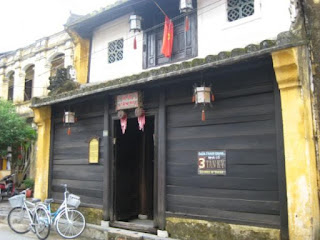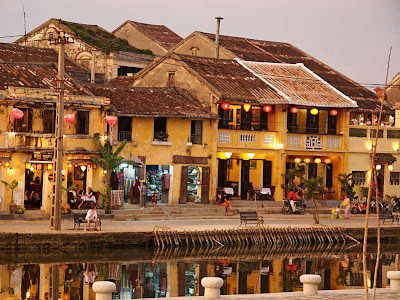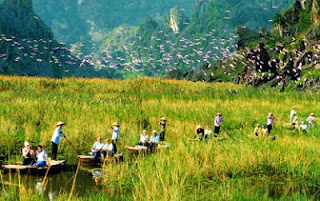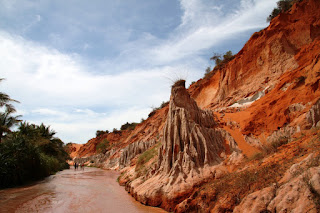QUANG NAM PROVINCE Capital: Tam Ky City
Tourist Highlights: Hoi An Ancient Town, My Son Sanctuary, Tra Kieu Citadel
Tourist Highlights: Hoi An Ancient Town, My Son Sanctuary, Tra Kieu Citadel
The tourist potential of Quang Nam is indeed great, as there are a variety of attractions to please all visitors.
The province was founded in 1831, but has a much longer history since the Sa Huynh culture flourished in Quang Nam during the Iron Age, over 3,000 years ago.
The first inhabitants of this region were the ancestors of the Cham people. Many majestic palaces, temples and military relics from the 1st to the 13th centuries still remain in the ancient capital of Tra Kieu, My Son...
The Cham towers in Bang An, Chien Dan and Khuong My are tokens of the excellent creative talents of the Cham people in music, art, customs, and festivities. As for Hoi An, it is one of the most ancient towns of Southeast Asia and it has luckily been kept almost intact until today.
This province is home to the two World Cultural Heritage Sites of My Son and Hoi An.
Hoi An Ancient Town
Hoi An is located 30km south of Da Nang along the Thu Bon River. Known as Faifo to early Western merchants, it was a major trading centre in Southeast Asia between the 16th and 17th centuries. Hoi An was also an important port for Dutch, Portuguese, Italian, Chinese, Japanese and other merchant vessels from the Far East (later supplanted by Da Nang).
In the city, several streets have been kept relatively intact. Ali the houses were made of wood and were decorated with horizontal lacquered boards and vertical parallel panels engraved with Chinese characters. Pillars were engraved with ornamental designs. All together make Hoi An the most famous tourist destination of Quang Nam and Vietnam also. The most ancient city of Southeast Asian has been declared by UNESCO as a World Cultural Heritage Site.
In the city, several streets have been kept relatively intact. Ali the houses were made of wood and were decorated with horizontal lacquered boards and vertical parallel panels engraved with Chinese characters. Pillars were engraved with ornamental designs. All together make Hoi An the most famous tourist destination of Quang Nam and Vietnam also. The most ancient city of Southeast Asian has been declared by UNESCO as a World Cultural Heritage Site.
My Son Sanctuary
My Son Sanctuary is a group of temple-towers of Cham people. It lies in a narrow valley in Duy Tan Commune, Duy Xuyen District, 70km southwest of Da Nang City, 20km away from the Tra Kieu Citadel, and 40km away from the ancient city of Hoi An.
Various researches by archaeologists and architects have revealed that at the beginning, there was only one small wooden temple built by King Bhadresvara I in late 4th century. In the 7th century, King Sambhuvarman had it rebuilt, using more durable materials. From then on, successive Cham Kings, when enthroned, had their temple-towers constructed as offerings to their gods. During seven centuries (7th to 14th century), such temple-towers mushroomed in My Son, turning this land into a cultural, and religious center of the Cham Kingdom.
My Son was a complex of constructions, including different temple-towers and stela in various architectural styles. French researchers listed some 70 temple-towers there. However, time and war together have taken their toll on these relics. Now, only 20 temple-towers remain almost intact. The rest have been reduced to ruins. These vestiges are valuable treasures of information for studying the development of Cham culture. During its seven centuries of development, Cham arts produced many works equal to masterpieces of the world. Though less imposing than the Angkor in Cambodia and less diversified than the Pagan site in Myanmar, My Son is unique of its kind in Southeast Asia.
With its great value, in December 1999, the My Son Sanctuary has been recognized as a World Cultural Heritage Site by UNESCO. A Tourist destination you should not miss on your trips to Vietnam and Hoi An.
Tourist Attractions of Hoi An, Quang Nam
Various researches by archaeologists and architects have revealed that at the beginning, there was only one small wooden temple built by King Bhadresvara I in late 4th century. In the 7th century, King Sambhuvarman had it rebuilt, using more durable materials. From then on, successive Cham Kings, when enthroned, had their temple-towers constructed as offerings to their gods. During seven centuries (7th to 14th century), such temple-towers mushroomed in My Son, turning this land into a cultural, and religious center of the Cham Kingdom.
My Son was a complex of constructions, including different temple-towers and stela in various architectural styles. French researchers listed some 70 temple-towers there. However, time and war together have taken their toll on these relics. Now, only 20 temple-towers remain almost intact. The rest have been reduced to ruins. These vestiges are valuable treasures of information for studying the development of Cham culture. During its seven centuries of development, Cham arts produced many works equal to masterpieces of the world. Though less imposing than the Angkor in Cambodia and less diversified than the Pagan site in Myanmar, My Son is unique of its kind in Southeast Asia.
With its great value, in December 1999, the My Son Sanctuary has been recognized as a World Cultural Heritage Site by UNESCO. A Tourist destination you should not miss on your trips to Vietnam and Hoi An.
Tourist Attractions of Hoi An, Quang Nam
Japanese Covered Bridge
The Japanese Covered Bridge, also called the Pagoda Bridge, was built in the 16th century and is still incredibly well-preserved. On the northern side of the bridge is a Japanese pagoda to protect sailors. There are statues of two dogs located at the western end of the bridge and two monkeys at the eastern end. It is said that the construction started in the year of the monkey and finished in the year of the dog, according to Chinese calendar. Other legend is said that the statues on the bridge might have been put .there by the Japanese to control this monster, since the dog and the monkey are sacred animals according to their Totem religion.
This tourist attraction of Hoi An had being printed on the 20,000 VND bill of Vietnam.
Quan Cong Temple
Located at 24 Tran Phu St., Quan Cong Temple is one of the typical temples in Hoi An's old quarter. Built in 1653, it was dedicated to Quan Thanh De Quan (Quan Van Truong), a general in the three-kingdom period of ancient China who was a model of loyalty to the king and a dutiful son to his parents.
Quan Cong Temple was constructed according to the Chinese character "Quoc", with many houses combined together. The houses are linked together by rafters, and roofed with colourful glazed pipe-shaped tiles. They are also decorated with colourful porcelain lemon-tree flowers, dragons and small lions.
The temple was restored many times, in 1827, 1864, 1904 and 1966. Today, it still houses an archive of precious objects such as an honoured letter to the Emperor, 30 horizontal lacquered boards engraved with Chinese characters, 10 pairs of parallel sentences and the statues of Quan Cong, Quan Binh, and Chau Thuong.
Quan Cong Temple was constructed according to the Chinese character "Quoc", with many houses combined together. The houses are linked together by rafters, and roofed with colourful glazed pipe-shaped tiles. They are also decorated with colourful porcelain lemon-tree flowers, dragons and small lions.
The temple was restored many times, in 1827, 1864, 1904 and 1966. Today, it still houses an archive of precious objects such as an honoured letter to the Emperor, 30 horizontal lacquered boards engraved with Chinese characters, 10 pairs of parallel sentences and the statues of Quan Cong, Quan Binh, and Chau Thuong.
Assembly Hall of Cantonese Chinese Congregation
The Assembly Hall of the Cantonese Chinese Congregation (Hoi Quan Quang Dong), located at 176 Tran Phu St. in Hoi An, was built in 1855 by members of the local Cantonese community. It was later restored in 1915 and again in 1990.
It was constructed according to the Chinese character "Quoc" and visitors will be amazed by its monumental and grand architecture in comparison with the other surrounding assembly halls.
Many ancient objects still remain inside, including four horizontal lacquered boards engraved with Chinese characters, a large 1.6m-tall and 0.6m-wide bronze incense burner, a pair of Chinese porcelain enamelled terra-cotta chairs and many other precious objects that belonged to the Chinese community of Hoi An.
The Assembly Hall is open daily from 6am -7.30am and 1pm - 5.30pm.
The Assembly Hall of the Cantonese Chinese Congregation (Hoi Quan Quang Dong), located at 176 Tran Phu St. in Hoi An, was built in 1855 by members of the local Cantonese community. It was later restored in 1915 and again in 1990.
It was constructed according to the Chinese character "Quoc" and visitors will be amazed by its monumental and grand architecture in comparison with the other surrounding assembly halls.
Many ancient objects still remain inside, including four horizontal lacquered boards engraved with Chinese characters, a large 1.6m-tall and 0.6m-wide bronze incense burner, a pair of Chinese porcelain enamelled terra-cotta chairs and many other precious objects that belonged to the Chinese community of Hoi An.
The Assembly Hall is open daily from 6am -7.30am and 1pm - 5.30pm.
Tan Ky House
Tan Ky House tourist destination located at 101 Nguyen Thai Hoc Road, was constructed almost two centuries ago as the house of a Vietnamese merchant. It has always been lovingly preserved and now looks almost exactly as it did in the early 19th century.
The design of Tan Ky House shows how local architecture incorporated Japanese and Chinese influences. Japanese elements include the crab shell-shaped ceiling support ed by three beams in the living room. Chinese poems written in mother-of-pearl are hanging from a number of the columns that hold up the roof.
The design of Tan Ky House shows how local architecture incorporated Japanese and Chinese influences. Japanese elements include the crab shell-shaped ceiling support ed by three beams in the living room. Chinese poems written in mother-of-pearl are hanging from a number of the columns that hold up the roof.
 |
| Tan Ky House |
Phuoc Kien Assembly Hall
Phuoc Kien Assembly Hall, also called Kim Son Pagoda, was built in Hoi An in 1692 by Chinese Phuoc Kien merchants. It has since been restored and enhanced many times. Because it was used for worship as well as for meetings by the Chinese from Phuoc Kien Province, this construction is now called the Phuoc Kien Assembly Hall.
The Holy Mother and the Goddess of the Sea, Thien Hau, are worshipped in the main sanctuary. The Phuoc Kien ancestors and the God of Prosperity are worshipped in the sanctuary behind the main one. This temple is architecturally unique with its artistic ornaments and beautiful statues. The Chinese architectural style combined with Vietnamese workmanship has enriched it with Hoi An's cultural character. The Phuoc Kien Assembly Hall is located at 46 Tran Phu St. and is open for tourist from 7.30am to 12 noon and from 2pm to 5.30pm.
The Holy Mother and the Goddess of the Sea, Thien Hau, are worshipped in the main sanctuary. The Phuoc Kien ancestors and the God of Prosperity are worshipped in the sanctuary behind the main one. This temple is architecturally unique with its artistic ornaments and beautiful statues. The Chinese architectural style combined with Vietnamese workmanship has enriched it with Hoi An's cultural character. The Phuoc Kien Assembly Hall is located at 46 Tran Phu St. and is open for tourist from 7.30am to 12 noon and from 2pm to 5.30pm.
Thu Bon River
Thu Bon River is one of the nicest waterways in Viet Nam. As such, it has been repeatedly portrayed in poetry. The river begins at an altitude of 2,598m in the Ngoc Linh Mountain and then runs across the south-western and mountainous area to meet the Tien and Tranh Rivers at Que Tan. From there, it flows through Que Son, Dai Loc, Duy Xuyen, Dien Ban, Hoi An, and finally into the sea at Cua Dai Beach.
From Hoi An, visitors can rent a boat and stop at the beautiful villages located along the river.
From Hoi An, visitors can rent a boat and stop at the beautiful villages located along the river.
Tourist guides to Hoi An and Quang Nam, Vietnam.
Tourist destinations of Hoi An, Vietnam.
















